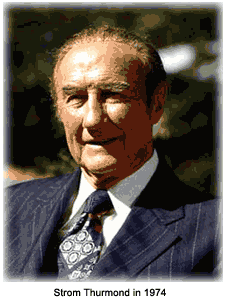President Franklin Roosevelt's electoral body in 1945 had included a diverse, in fact contradictory, set of elements — both conservatives and liberals, northern and southern Democrats and Republicans. By 1948, however, the civil rights issue revealed the real philosophical differences between northern and southern Democrats as never before. The move of Southern states from solidly Democrat to solidly Republican began to take place. In that environment, the Dixiecrats and the “Southern Strategy” was born.
 At the 1948 Democratic National Convention, a group led by Senator Hubert Humphrey of Minnesota proposed some controversial new civil rights planks of racial integration and the reversal of Jim Crow laws to be included in the party platform. Southern Democrats were dismayed. President Harry S. Truman was caught in the middle for his recent executive order to racially integrate the armed forces. As a compromise, he proposed the adoption of only those planks that had been in the 1944 platform. That was not enough for the liberals. Truman's own civil rights initiatives had made the civil rights debate unavoidable.
The planks were adopted and 35 southern Democrats walked out in protest. They formed the States' Rights Democratic Party, which became popularly known as the Dixiecrats. Their campaign slogan was “Segregation Forever!” Their platform also included “states’ rights” to freedom from governmental interference in an individual's or organization's prerogative to do business with whomever they wanted.
New York moderate Nelson Rockefeller's defeat in the presidential primary election marked the beginning of the end of moderates and liberals in the Republican Party.
Clearer political and ideological lines began to be drawn between the Democrat and Republican parties as moderates and liberals converted from Republican to Democrat. Conservatives in the Democratic Party began to move to the increasingly conservative Republican Party.
Meeting in Birmingham, Alabama, the Dixiecrats nominated South Carolina governor Strom Thurmond as their presidential candidate, and Mississippi governor Field J. Wright, as their vice-presidential nominee. The party platform represented the openly racist views of most white southerners of the time. It opposed abolition of the poll tax while endorsing segregation and the "racial integrity" of each race. In the November election, Thurmond carried the states of Alabama, Louisiana, Mississippi, and South Carolina. Although Thurmond did not win the election, he received well over a million popular votes and 39 electoral votes.
At the 1948 Democratic National Convention, a group led by Senator Hubert Humphrey of Minnesota proposed some controversial new civil rights planks of racial integration and the reversal of Jim Crow laws to be included in the party platform. Southern Democrats were dismayed. President Harry S. Truman was caught in the middle for his recent executive order to racially integrate the armed forces. As a compromise, he proposed the adoption of only those planks that had been in the 1944 platform. That was not enough for the liberals. Truman's own civil rights initiatives had made the civil rights debate unavoidable.
The planks were adopted and 35 southern Democrats walked out in protest. They formed the States' Rights Democratic Party, which became popularly known as the Dixiecrats. Their campaign slogan was “Segregation Forever!” Their platform also included “states’ rights” to freedom from governmental interference in an individual's or organization's prerogative to do business with whomever they wanted.
New York moderate Nelson Rockefeller's defeat in the presidential primary election marked the beginning of the end of moderates and liberals in the Republican Party.
Clearer political and ideological lines began to be drawn between the Democrat and Republican parties as moderates and liberals converted from Republican to Democrat. Conservatives in the Democratic Party began to move to the increasingly conservative Republican Party.
Meeting in Birmingham, Alabama, the Dixiecrats nominated South Carolina governor Strom Thurmond as their presidential candidate, and Mississippi governor Field J. Wright, as their vice-presidential nominee. The party platform represented the openly racist views of most white southerners of the time. It opposed abolition of the poll tax while endorsing segregation and the "racial integrity" of each race. In the November election, Thurmond carried the states of Alabama, Louisiana, Mississippi, and South Carolina. Although Thurmond did not win the election, he received well over a million popular votes and 39 electoral votes.
 By 1952, southern Democrats had concluded that they could exercise more influence through the Democratic Party and therefore returned to the fold. They remained in the Democratic fold, restive, until the candidacy of Republican conservative Barry Goldwater liberated them in 1964 by refreshing some of the Dixiecrat ideologies and therefore accelerated the transition from a solid South for the Democrats to one for the Republicans. Strom Thurmond switched to the Republican Party that year and remained there until his death in December 2003.
Other presidential candidates, such as Republican Richard M. Nixon in 1968, have effectively used the Southern strategy of "states' rights" and racial inequality to garner votes from the racially conservative electorate in the southern states.
By 1952, southern Democrats had concluded that they could exercise more influence through the Democratic Party and therefore returned to the fold. They remained in the Democratic fold, restive, until the candidacy of Republican conservative Barry Goldwater liberated them in 1964 by refreshing some of the Dixiecrat ideologies and therefore accelerated the transition from a solid South for the Democrats to one for the Republicans. Strom Thurmond switched to the Republican Party that year and remained there until his death in December 2003.
Other presidential candidates, such as Republican Richard M. Nixon in 1968, have effectively used the Southern strategy of "states' rights" and racial inequality to garner votes from the racially conservative electorate in the southern states.